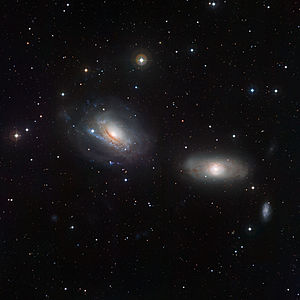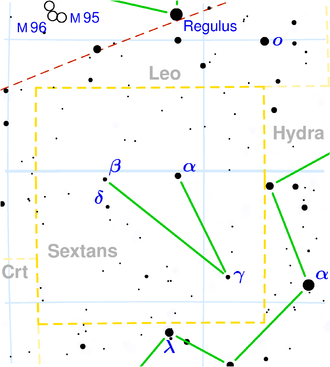NGC 3166
| Galaxy NGC 3166 |
|
|---|---|

|
|
| NCG 3166 (right) next to NGC 3169 (left) taken with the Wide Field Imager 2.2 meter telescope of the MPG / ESO in the La Silla Observatory ; on the right below you can see NGC 3165 . | |
| AladinLite | |
| Constellation | sextant |
|
Position equinox : J2000.0 , epoch : J2000.0 |
|
| Right ascension | 10 h 13 m 45.8 s |
| declination | + 03 ° 25 ′ 30 ″ |
| Appearance | |
| Morphological type | SAB (rs) 0 / a; HII / LINER |
| Brightness (visual) | 10.5 mag |
| Brightness (B-band) | 11.4 mag |
| Angular expansion | 4.8 ′ × 2.3 ′ |
| Position angle | 87 ° |
| Surface brightness | 13.0 mag / arcmin² |
| Physical data | |
| Affiliation | LGG 192 |
| Redshift | (4440 ± 223) · 10 −6 |
| Radial velocity | 1328 ± 67 km / s |
|
Stroke distance v rad / H 0 |
(54 ± 4) · 10 6 ly (16.6 ± 1.2) Mpc |
| diameter | 90,000 ly |
| history | |
| discovery | Wilhelm Herschel |
| Discovery date | December 19, 1783 |
| Catalog names | |
| NGC 3166 • UGC 5516 • PGC 29814 • CGCG 036-064 • MCG + 01-26-24 • IRAS 10111 + 0340 • 2MASX J10134567 + 0325288 • GC 2038 • H I 3 • h 684 • KCPG 228A, LDCE 0715 NED002 | |
NGC 3166 is a lenticular galaxy with an active nucleus of the Hubble type SB0-a and is located in the constellation Sextans south of the celestial equator . It is estimated to be 54 million light years from the Milky Way and about 90,000 light years in diameter.
NGC 3166 interacts with the galaxies NGC 3165 and NGC 3169 , as can be seen in the right image.
The object was discovered by Wilhelm Herschel on December 19, 1783 .
Web links
- SIMBAD Astronomical Database
- ESO: A Disheveled Pair of Galaxies + Photos, Map & Animation - April 20, 2011
